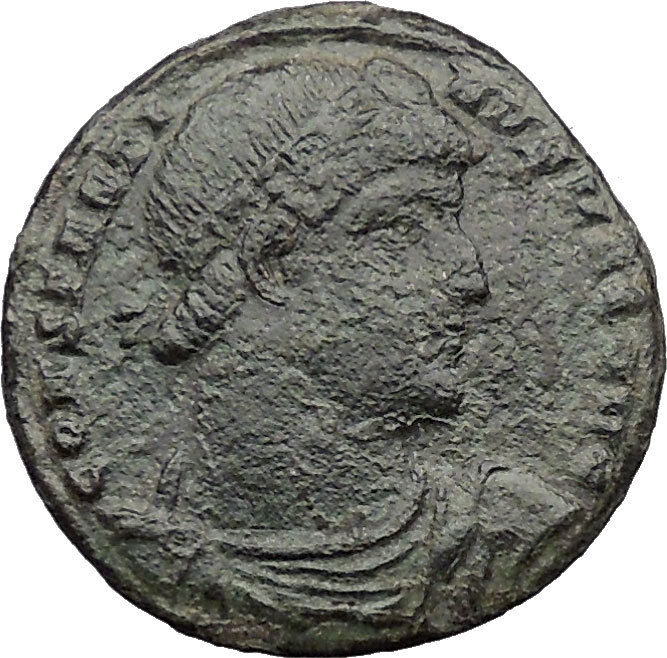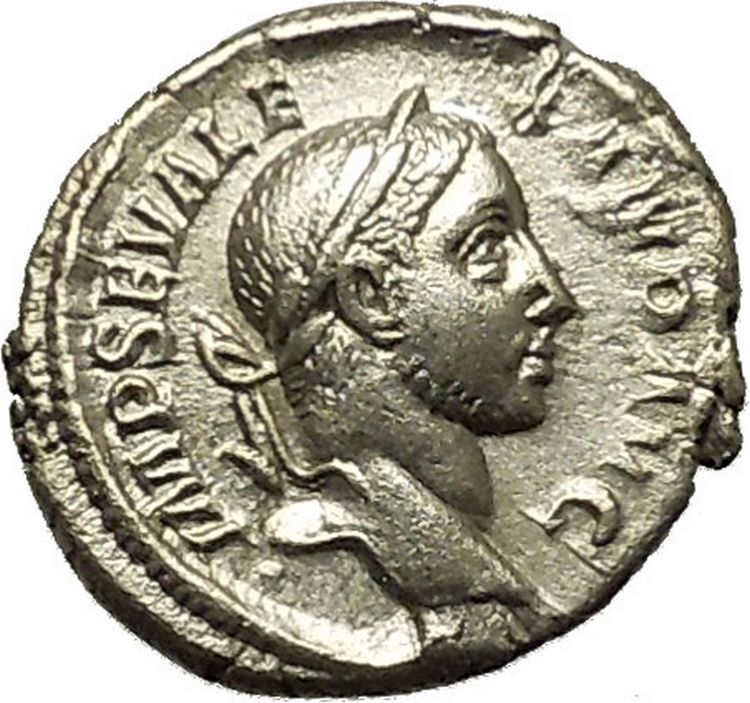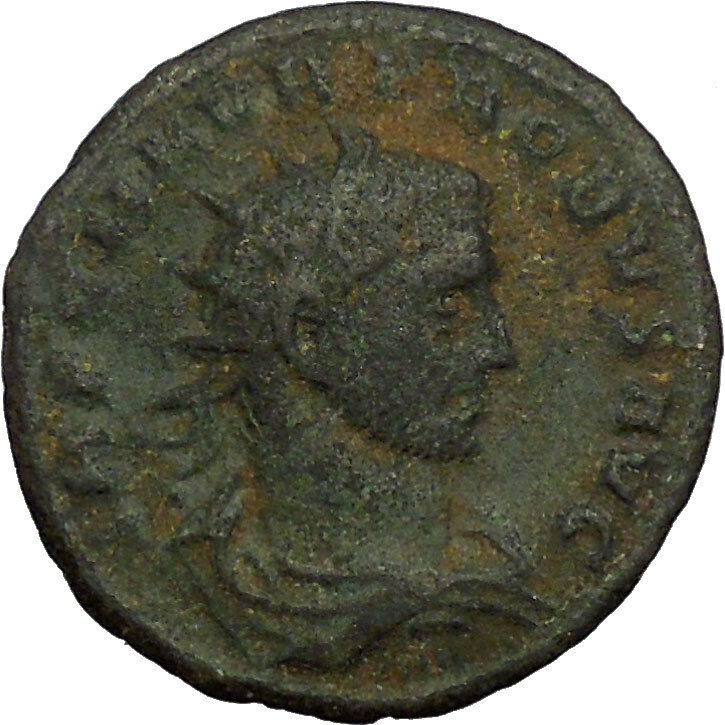|
Gallienus
–
Roman Emperor
: 253-268 A.D. – – Joint Rule with
Valerian I 253-260 A.D. –
Silvered Bronze Antoninianus 20mm (2.12 grams) Rome mint: 253-254 . A.D.
Reference: RIC 210 N right ; Cohen 361. Goebl 0626a; RIC 210 var (fieldmark
position).
GALLIENVS AVG, radiate head right
IOVI CONSERVAT,
Jupiter
standing left
holding thunderbolt & sceptre.
N in right field.
You are bidding on the exact item pictured,
provided with a Certificate of Authenticity and Lifetime Guarantee of
Authenticity.
In
Roman mythology
,
Jupiter
or
Jove was the
king of the gods
, and the god of
sky and
thunder
. He
is
 the equivalent of Zeus the equivalent of Zeus
in the
Greek pantheon
. He was called Iuppiter (or Diespiter)
Optimus Maximus (“Father God the Best and Greatest”). As the patron deity of
ancient
Rome
, he ruled over laws and social order. He was the chief god of the
Capitoline Triad
, with sister/wife
Juno
. Jupiter is also the father of the god
Mars
with Juno. Therefore, Jupiter is the grandfather of
Romulus and Remus
, the legendary founders of Rome. Jupiter was venerated in
ancient Roman religion
, and is still venerated in
Roman Neopaganism
. He is a son of
Saturn
, along with brothers
Neptune
and
Pluto
.
He is also the brother/husband of
Ceres
(daughter of Saturn and mother of
Proserpina
),
brother of Veritas
(daughter of Saturn), and father of
Mercury
.
Gallienus (Latin:
Publius Licinius Egnatius Gallienus Augustus;
c. 218 – 268) was
Roman Emperor
with his father
Valerian
from 253 to 260 and alone from 260 to
268. He ruled during the
Crisis of the Third Century
that nearly caused
the collapse of the empire. While he won a number of military victories, he was
unable to prevent the secession of important provinces.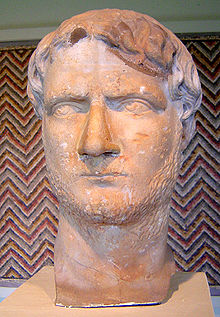
Life
Rise to power
The exact birth date of Gallienus is unknown. The Greek chronicler
John Malalas
and the Epitome de Caesaribus
report that he was about 50 years old at the time of his death, meaning he was
born around 218. He was the son of emperor
Valerian
and
Mariniana
, who may have been of senatorial
rank, possibly the daughter of
Egnatius Victor Marinianus
, and his brother was
Valerianus Minor
. Inscriptions on coins connect
him with Falerii
in
Etruria
, which may have been his birthplace; it
has yielded many inscriptions relating to his mother’s family, the Egnatii.[3]
Gallienus married
Cornelia Salonina
about ten years before his
accession to the throne. She was the mother of three princes:
Valerian II
, who died in 258;
Saloninus
, who was named co-emperor but was
murdered in 260 by the army of general Postumus; and
Marinianus
, who was killed in 268, shortly
after his father was assassinated.
When
Valerian
was proclaimed Emperor on 22 October
253, he asked the
Senate
to ratify the elevation of Gallienus to
Caesar and
Augustus
. He was also designated
Consul Ordinarius
for 254. As
Marcus Aurelius
and his adopted brother
Lucius Verus
had done a century earlier,
Gallienus and his father divided the Empire. Valerian left for the East to stem
the Persian threat, and Gallienus remained in Italy to repel the Germanic tribes
on the Rhine
and
Danube
.
Division of the empire
had become necessary due
to its sheer size and the numerous threats it faced, and it facilitated
negotiations with enemies who demanded to communicate directly with the emperor.
Early
reign and the revolt of Ingenuus
Gallienus spent most of his time in the provinces of the Rhine area (Germania
Inferior,
Germania Superior
,
Raetia
, and
Noricum
), though he almost certainly visited
the Danube
area and
Illyricum
during 253 to 258. According to
Eutropius and Aurelius Victor, he was particularly energetic and successful in
preventing invaders from attacking the German provinces and Gaul, despite the
weakness caused by Valerian’s march on Italy against
Aemilianus
in 253. According to numismatic
evidence, he seems to have won many victories there, and a victory in
Roman Dacia
might also be dated to that period.
Even the hostile Latin tradition attributes success to him at this time.
In 255 or 257, Gallienus was made Consul again, suggesting that he briefly
visited Rome on those occasions, although no record survives. During his Danube
sojourn (Drinkwater suggests in 255 or 256), he proclaimed his elder son
Valerian II
Caesar and thus official heir to
himself and Valerian I; the boy probably joined Gallienus on campaign at that
time, and when Gallienus moved west to the Rhine provinces in 257, he remained
behind on the Danube as the personification of Imperial authority.
Sometime between 258 and 260 (the exact date is unclear), while Valerian was
distracted with the ongoing invasion of Shapur in the East, and Gallienus was
preoccupied with his problems in the West,
Ingenuus
, governor of at least one of the
Pannonian provinces, took advantage and declared himself emperor. Valerian II
had apparently died on the Danube, most likely in 258. Ingenuus may have been
responsible for that calamity. Alternatively, the defeat and capture of Valerian
at the
battle of Edessa
may have been the trigger for
the subsequent revolts of Ingenuus,
Regalianus
, and
Postumus
. In any case, Gallienus reacted with
great speed. He left his son
Saloninus
as Caesar at
Cologne
, under the supervision of Albanus (or
Silvanus) and the military leadership of Postumus. He then hastily crossed the
Balkans
, taking with him the new cavalry corps
(comitatus) under the command of
Aureolus
and defeated Ingenuus at
Mursa
or
Sirmium
.The victory must be attributed mainly
to the cavalry and its brilliant commander. Ingenuus was killed by his own
guards or committed suicide by drowning himself after the fall of his capital,
Sirmium.
Invasion of the
Alamanni
A major invasion by the
Alemanni
and other Germanic tribes occurred
between 258 and 260 (it is hard to fix the precise date of these
events),probably due to the vacuum left by the withdrawal of troops supporting
Gallienus in the campaign against Ingenuus.
Franks
broke through the lower Rhine, invading
Gaul, some reaching as far as southern Spain, sacking Tarraco (modern
Tarragona
).The Alamanni invaded, probably
through
Agri Decumates
(an area between the upper Rhine
and the upper Danube), likely followed by the
Juthungi
. After devastating Germania Superior
and Raetia (parts of southern
France
and
Switzerland
), they entered Italy, the first
invasion of the Italian peninsula, aside from its most remote northern regions,
since Hannibal
500 years before. When invaders
reached the outskirts of Rome, they were repelled by an improvised army
assembled by the Senate, consisting of local troops (probably prǣtorian guards)
and the strongest of the civilian population.On their retreat through northern
Italy, they were intercepted and defeated in the
battle of Mediolanum
(near present day
Milan
) by Gallienus’ army, which had advanced
from Gaul, or from the Balkans after dealing with the Franks.The battle of
Mediolanum was decisive, and the Alamanni didn’t bother the empire for the next
ten years. The Juthungi managed to cross the Alps with their valuables and
captives from Italy. An historian in the 19th century suggested that the
initiative of the Senate gave rise to jealousy and suspicion by Gallienus, thus
contributing to his exclusion of senators from military commands.
The revolt of
Regalianus
Around the same time,
Regalianus
, a military commander of
Illyricum
, was proclaimed Emperor. The reasons
for this are unclear, and the Historia Augusta (almost the sole resource
for these events) does not provide a credible story. It is possible the seizure
can be attributed to the discontent of the civilian and military provincials,
who felt the defense of the province was being neglected.
Regalianus held power for some six months and issued coins bearing his image.
After some success against the
Sarmatians
, his revolt was put down by the
invasion of Roxolani
into
Pannonia
, and Regalianus himself was killed
when the invaders took the city of
Sirmium
. There is a suggestion that Gallienus
invited Roxolani to attack Regalianus, but other historians dismiss the
accusation.It is also suggested that the invasion was finally checked by
Gallienus near Verona
and that he directed the restoration of
the province, probably in person.
Capture of Valerian, revolt of Macrianus
In the East, Valerian was confronted with serious troubles. A band of
Scythians
set a naval raid against
Pontus
, in the northern part of modern Turkey.
After ravaging the province, they moved south into
Cappadocia
. Valerian led troops to intercept
them but failed, perhaps because of a plague that gravely weakened his army, as
well as the contemporary invasion of northern
Mesopotamia
by
Shapur I
, ruler of the
Sassanid Empire
.
In 259 or 260, the Roman army was defeated in the
Battle of Edessa
, and Valerian was taken
prisoner. Shapur’s army raided
Cilicia
and
Cappadocia
(in present day
Turkey
), sacking, as Shapur’s inscriptions
claim, 36 cities. It took a rally by an officer
Callistus
(Balista), a fiscal official named
Fulvius Macrianus
, the remains of the Eastern
Roman legions, and
Odenathus
and his
Palmyrene
horsemen to turn the tide against
Shapur. The Persians were driven back, but Macrianus proclaimed his two sons
Quietus
and
Macrianus
(sometimes misspelled Macrinus) as
emperors. Coins struck for them in major cities of the East indicate
acknowledgement of the usurpation. The two Macriani left Quietus, Ballista, and,
presumably, Odenathus to deal with the Persians while they invaded Europe with
an army of 30,000 men, according to the Historia Augusta. At first they
met no opposition. The Pannonian legions joined the invaders, being resentful of
the absence of Gallienus. He sent his successful commander Aureolus against the
rebels, however, and the decisive battle was fought in the spring or early
summer of 261, most likely in Illyricum, although
Zonaras
locates it in Pannonia. In any case,
the army of the usurpers surrendered, and their two leaders were killed.
In the aftermath of the battle, the rebellion of Postumus had already
started, so Gallienus had no time to deal with the rest of the usurpers, namely
Balista and Quietus. He came to an agreement with Odenathus, who had just
returned from his victorious Persian expedition. Odenathus received the title of
dux Romanorum and besieged the usurpers, who were based at
Emesa
. Eventually, the people of Emesa killed
Quietus, and Odenathus arrested and executed Balista about November 261.
The revolt of Postumus
After the defeat at Edessa, Gallienus lost control over the provinces of
Britain, Spain, parts of Germania, and a large part of Gaul when another
general, Postumus
, declared his own realm (usually known
today as the
Gallic Empire
). The revolt partially coincided
with that of
Macrianus
in the East. Gallienus had installed
his son Saloninus and his guardian,
Silvanus
, in Cologne in 258. Postumus, a
general in command of troops on the banks of the Rhine, defeated some raiders
and took possession of their spoils. Instead of returning it to the original
owners, he preferred to distribute it amongst his soldiers. When news of this
reached Silvanus, he demanded the spoils be sent to him. Postumus made a show of
submission, but his soldiers mutinied and proclaimed him Emperor. Under his
command, they besieged Cologne, and after some weeks the defenders of the city
opened the gates and handed Saloninus and Silvanus to Postumus, who had them
killed. The dating of these events is not accurate, but they apparently occurred
just before the end of 260. Postumus claimed the consulship for himself and one
of his associates, Honoratianus, but according to D.S. Potter, he never tried to
unseat Gallienus or invade Italy.
Upon receiving news of the murder of his son, Gallienus began gathering
forces to face Postumus. The invasion of the Macriani forced him to dispatch
Aureolus with a large force to oppose them, however, leaving him with
insufficient troops to battle Postumus. After some initial defeats, the army of
Aureolus, having defeated the Macriani, rejoined him, and Postumus was expelled.
Aureolus was entrusted with the pursuit and deliberately allowed Postumus to
escape and gather new forces. Gallienus returned in 263 or 265 and surrounded
Postumus in an unnamed Gallic city. During the siege, Gallenus was severely
wounded by an arrow and had to leave the field. The standstill persisted until
the death of Gallienus, and the
Gallic Empire
remained independent until 274.
The revolt of
Aemilianus
In 262, the mint in
Alexandria
started to again issue coins for
Gallienus, demonstrating that Egypt had returned to his control after
suppressing the revolt of the Macriani. In spring of 262, the city was wrenched
by civil unrest as a result of a new revolt. The rebel this time was the prefect
of Egypt,
Lucius Mussius Aemilianus
, who had already
given support to the revolt of the Macriani. The correspondence of bishop
Dionysius of Alexandria
provides a colourful
commentary on the sombre background of invasion, civil war, plague, and famine
that characterized this age.
Knowing he could not afford to lose control of the vital Egyptian granaries,
Gallienus sent his general Theodotus against Aemilianus, probably by a naval
expedition. The decisive battle probably took place near Thebes, and the result
was a clear defeat of Aemilianus. In the aftermath, Gallienus became Consul
three more times in 262, 264, and 266.
Herulian invasions, revolt of Aureolus, conspiracy and death
In the years 267–269, Goths and other barbarians invaded the empire in great
numbers. Sources are extremely confused on the dating of these invasions, the
participants, and their targets. Modern historians are not even able to discern
with certainty whether there were two or more of these invasions or a single
prolonged one. It seems that, at first, a major naval expedition was led by the
Heruli
starting from north of the
Black Sea
and leading in the ravaging of many
cities of Greece (among them,
Athens
and
Sparta
). Then another, even more numerous army
of invaders started a second naval invasion of the empire. The Romans defeated
the barbarians on sea first. Gallienus’ army then won a battle in
Thrace
, and the Emperor pursued the invaders.
According to some historians, he was the leader of the army who won the great
Battle of Naissus
, while the majority believes
that the victory must be attributed to his successor,
Claudius II
.
In 268, at some time before or soon after the battle of Naissus, the
authority of Gallienus was challenged by
Aureolus
, commander of the cavalry stationed in
Mediolanum
(Milan),
who was supposed to keep an eye on
Postumus
. Instead, he acted as deputy to
Postumus until the very last days of his revolt, when he seems to have claimed
the throne for himself. The decisive battle took place at what is now
Pontirolo Nuovo
near Milan; Aureolus was
clearly defeated and driven back to Milan. Gallienus laid siege to the city but
was murdered during the siege. There are differing accounts of the murder, but
the sources agree that most of Gallienus’ officials wanted him dead. According
to the
Historia Augusta
, an unreliable source compiled
long after the events it describes, a conspiracy was led by the commander of the
guard
Aurelius Heraclianus
and Marcianus.
Cecropius, commander of the Dalmatians, spread the word that the forces of
Aureolus were leaving the city, and Gallienus left his tent without his
bodyguard, only to be struck down by Cecropius.One version has Claudius selected
as Emperor by the conspirators, another chosen by Gallienus on his death bed;
the Historia Augusta was concerned to substantiate the descent of the
Constantinian dynasty
from Claudius, and this
may explain its accounts, which do not involve Claudius in the murder. The other
sources (Zosimus
i.40 and
Zonaras
xii.25) report that the conspiracy was
organized by Heraclianus, Claudius, and
Aurelian
.
According to Aurelius Victor and Zonaras, on hearing the news that Gallienus
was dead, the Senate in Rome ordered the execution of his family (including his
brother Valerianus and son Marinianus) and their supporters, just before
receiving a message from Claudius to spare their lives and deify his
predecessor.
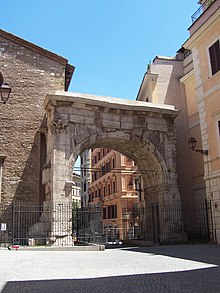
Arch of Gallienus
in Rome, 262 –
dedicated to, rather than built by, Gallienus.
Legacy
Gallienus was not treated favorably by ancient historians, partly due to the
secession of Gaul and
Palmyra
and his inability to win them back.
According to modern scholar Pat Southern, some historians now see him in a more
positive light.Gallienus produced some useful reforms. He contributed to
military history as the first to commission primarily
cavalry
units, the
Comitatenses
, that could be dispatched anywhere
in the Empire in short order. This reform arguably created a precedent for the
future emperors
Diocletian
and
Constantine I
.
The biographer
Aurelius Victor
reports that Gallienus forbade
senators
from becoming military commanders.
This policy undermined senatorial power, as more reliable
equestrian
commanders rose to prominence. In
Southern’s view, these reforms and the decline in senatorial influence not only
helped Aurelian to salvage the Empire, but they also make Gallienus one of the
emperors most responsible for the creation of the
Dominate
, along with
Septimius Severus
, Diocletian, and Constantine
I.
By portraying himself with the attributes of the gods on his coinage,
Gallienus began the final separation of the Emperor from his subjects.A late
bust of Gallienus (see above) depicts him with a largely blank face, gazing
heavenward, as seen on the famous stone head of
Constantine I
. One of the last rulers of Rome
to be theoretically called “Princeps”, or First Citizen, Gallienus’ shrewd
self-promotion assisted in paving the way for those who would be addressed with
the words “Dominus et Deus” (Lord and God).
-
Antoninianus
issued to celebrate
LEG II ITAL VII P VII F, “ItalicaLegio
II seven
times faithful and loyal.”
-
Antoninianus issued to celebrate LEG III ITAL VI P VI F,
“ItalicaLegio
III six times
faithful and loyal.”
-
Antoninianus issued to celebrate LEG VII MAC VI P VI F,
“MacedonicaLegio
VII six
times faithful and loyal.”
-
Antoninianus issued to celebrate LEG VII CLA VI P VI F,
“ClaudiaLegio
VII six

In
ancient Roman religion
and
myth
, Jupiter (Latin:
Iuppiter) or Jove is the
king of the gods
and the
god of sky
and
thunder
. Jupiter was the chief deity of Roman
state religion throughout the
Republican
and
Imperial
eras, until the Empire
came under Christian rule
. In
Roman mythology
, he negotiates with
Numa Pompilius
, the second
king of Rome
, to establish principles of Roman
religion such as sacrifice.
Jupiter is usually thought to have originated as a sky god. His identifying
implement is the
thunderbolt
, and his primary sacred animal is
the eagle, which held precedence over other birds in the taking of
auspices
and became one of the most common
symbols of the
Roman army
(see
Aquila
). The two emblems were often combined to
represent the god in the form of an eagle holding in its claws a thunderbolt,
frequently seen on Greek and Roman coins. As the sky-god, he was a divine
witness to oaths, the sacred trust on which justice and good government depend.
Many of his functions were focused on the
Capitoline
(“Capitol Hill”), where the
citadel
was located. He was the chief deity of
the
early Capitoline Triad
with
Mars
and
Quirinus
. In the
later Capitoline Triad
, he was the central
guardian of the state with
Juno
and
Minerva
. His sacred tree was the oak.
The Romans regarded Jupiter as the
equivalent
of Greek
Zeus, and in
Latin literature
and
Roman art
, the myths and iconography of Zeus
are adapted under the name Iuppiter. In the Greek-influenced tradition,
Jupiter was the brother of
Neptune
and
Pluto
. Each presided over one of the three
realms of the universe: sky, the waters, and the underworld. The
Italic
Diespiter was also a sky god who
manifested himself in the daylight, usually but not always identified with
Jupiter. The
Etruscan
counterpart was
Tinia
and
Hindu
counterpart is
Indra
.
Relation to other gods
Archaic Triad
The Archaic Triad is a theological structure (or system) consisting of the
gods Jupiter, Mars and Quirinus. It was first described by Wissowa, and the
concept was developed further by Dumézil. The three-function hypothesis of
Indo-European society
advanced by Dumézil holds
that in prehistory, society was divided into three classes (priests, warriors
and craftsmen) which had as their religious counterparts the divine figures of
the sovereign god, the warrior god and the civil god. The sovereign function
(embodied by Jupiter) entailed omnipotence; thence, a domain extended over every
aspect of nature and life. The colour relating to the sovereign function is
white.
The three functions are interrelated with one another, overlapping to some
extent; the sovereign function, although essentially religious in nature, is
involved in many ways in areas pertaining to the other two. Therefore, Jupiter
is the “magic player” in the founding of the Roman state and the fields of war,
agricultural plenty, human fertility and welth.
Capitoline Triad
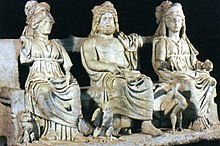
Capitoline Triad
The Capitoline Triad was introduced to Rome by the Tarquins. Dumézil thinks
it might have been an Etruscan (or local) creation based on Vitruvius’ treatise
on architecture, in which the three deities are associated as the most
important. It is possible that the Etruscans paid particular attention to
Menrva
(Minerva) as a goddess of destiny, in
addition to the royal couple Uni (Juno) and Tinia (Jupiter).[169]
In Rome, Minerva later assumed a military aspect under the influence of
Athena Pallas
(Polias). Dumézil argues that
with the advent of the Republic, Jupiter became the only king of Rome, no longer
merely the first of the great gods.
Jupiter and Minerva
Apart from being protectress of the arts and craft as Minerva Capta, who was
brought from Falerii, Minerva’s association to Jupiter and relevance to Roman
state religion is mainly linked to the
Palladium
, a wooden statue of Athena that could
move the eyes and wave the spear. It was stored in the penus interior,
inner penus of the aedes Vestae, temple of Vesta and considered the most
important among the
pignora imperii
, pawns of dominion, empire.[170]
In Roman traditional lore it was brought from Troy by Aeneas. Scholars though
think it was last taken to Rome in the third or second century BC.
Juno and Fortuna
The divine couple received from Greece its matrimonial implications, thence
bestowing on Juno the role of tutelary goddess of marriage (Iuno Pronuba).
The couple itself though cannot be reduced to a Greek apport. The association
of Juno and Jupiter is of the most ancient Latin theology.
Praeneste
offers a glimpse into original Latin
mythology: the local goddess
Fortuna
is represented as milking two infants,
one male and one female, namely Jove (Jupiter) and Juno. It seems fairly safe to
assume that from the earliest times they were identified by their own proper
names and since they got them they were never changed through the course of
history: they were called Jupiter and Juno. These gods were the most ancient
deities of every Latin town. Praeneste preserved divine filiation and infancy as
the sovereign god and his paredra Juno have a mother who is the primordial
goddess Fortuna Primigenia.[174]
Many terracotta statuettes have been discovered which represent a woman with a
child: one of them represents exactly the scene described by Cicero of a woman
with two children of different sex who touch her breast. Two of the votive
inscriptions to Fortuna associate her and Jupiter: ” Fortunae Iovi puero…” and
“Fortunae Iovis puero…”
In 1882 though R. Mowat published an inscription in which Fortuna is called
daughter of Jupiter, raising new questions and opening new perspectives
in the theology of Latin gods. Dumezil has elaborated an interpretative theory
according to which this aporia would be an intrinsic, fundamental feature
of Indoeuropean deities of the primordial and sovereign level, as it finds a
parallel in Vedic religion. The contradiction would put Fortuna both at the
origin of time and into its ensuing diachronic process: it is the comparison
offered by Vedic deity
Aditi
, the Not-Bound or Enemy of
Bondage, that shows that there is no question of choosing one of the two
apparent options: as the mother of the
Aditya
she has the same type of relationship
with one of his sons,
Dakṣa
, the minor sovereign. who represents the
Creative Energy, being at the same time his mother and daughter, as is
true for the whole group of sovereign gods to which she belongs. Moreover Aditi
is thus one of the heirs (along with
Savitr
) of the opening god of the Indoiranians,
as she is represented with her head on her two sides, with the two faces looking
opposite directions. The mother of the sovereign gods has thence two solidal but
distinct modalities of duplicity, i.e. of having two foreheads and a double
position in the genealogy. Angelo Brelich has interpreted this theology as the
basic opposition between the primordial absence of order (chaos) and the
organisation of the cosmos.
Janus
The relation of Jupiter to Janus is problematic. Varro defines Jupiter as the
god who has potestas (power) over the forces by which anything happens in
the world. Janus, however, has the privilege of being invoked first in rites,
since in his power are the beginnings of things (prima), the appearance
of Jupiter included.
Saturn
The
Latins
considered Saturn the predecessor of
Jupiter. Saturn reigned in
Latium
during a mythical
Golden Age
reenacted every year at the festival
of Saturnalia
. Saturn also retained primacy in
matters of agriculture and money. Unlike the Greek tradition of
Cronus
and Zeus, the usurpation of Saturn as
king of the gods by Jupiter was not viewed by the Latins as violent or hostile;
Saturn continued to be revered in his temple at the foot of the Capitol Hill,
which maintained the alternative name Saturnius into the time of Varro.[182]
A. Pasqualini has argued that Saturn was related to Iuppiter Latiaris,
the old Jupiter of the Latins, as the original figure of this Jupiter was
superseded on the Alban Mount, whereas it preserved its gruesome character in
the ceremony held at the sanctuary of the Latiar Hill in Rome which involved a
human sacrifice and the aspersion of the statue of the god with the blood of the
victim.
Fides
The abstract
personification
Fides (“Faith, Trust”) was one
of the oldest gods associated with Jupiter. As guarantor of public faith, Fides
had her temple on the Capitol (near that of Capitoline Jupiter).
Genius
Augustine quotes Varro who explains the genius as “the god who is in
charge and has the power to generate everything” and “the rational spirit of all
(therefore, everyone has their own)”. Augustine concludes that Jupiter should be
considered the genius of the universe.
G. Wissowa advanced the hypothesis that Semo
Sancus
is the genius of Jupiter.[189]
W. W. Fowler has cautioned that this interpretation looks to be an anachronism
and it would only be acceptable to say that Sancus is a Genius Iovius, as
it appears from the Iguvine Tables.
Censorinus cites
Granius Flaccus
as saying that “the Genius was
the same entity as the Lar” in his lost work De Indigitamentis. Dumézil
opines that the attribution of a Genius to the gods should be earlier than its
first attestation of 58 BC, in an inscription which mentions the Iovis Genius.
A connection between Genius and Jupiter would be apparent in
Plautus
‘ comedy
Amphitryon
, in which Jupiter takes up the
looks of Alcmena
‘s husband in order to seduce her: J.
Hubeaux sees there a reflection of the story that
Scipio Africanus
‘ mother conceived him with a
snake that was in fact Jupiter transformed. Scipio himself claimed that only he
would rise to the mansion of the gods through the widest gate..
It is noteworthy that among the Etruscan Penates there is a Genius
Iovialis who comes after Fortuna and Ceres and before Pales . Genius
Iovialis is one of the earthly Penates and not one of the Penates of
Jupiter though, as these were located in region I of Martianus Capella’ s
division of Heaven, while Genius appear in regions V and VI along with Ceres,
Favor (possibly a Roman approximation to an Etruscan male manifestation of
Fortuna) and Pales.
Victoria

Coin with
laureate
head of Jupiter (obverse)
and (reverse) Victory, standing (“ROMA” below in
relief
)
Victoria was connected to Iuppiter Victor in his role as bestower of
military victory. Jupiter, as a sovereign god, was considered as having the
power to conquer anyone and anything in a supernatural way; his contribution to
military victory was different from that of
Mars
(god of military valour). Victoria appears
first on the reverse of coins representing Venus (driving the quadriga of
Jupiter, with her head crowned and with a palm in her hand) during the first
Punic War. Sometimes, she is represented walking and carrying a trophy.
A temple was dedicated to the goddess afterwards on the Palatine, testifying
to her high station in the Roman mind. When
Hieron of Syracuse
presented a golden statuette
of the goddess to Rome, the Senate had it placed in the temple of Capitoline
Jupiter among the greatest (and most sacred) deities. Although Victoria played a
significant role in the religious ideology of the late Republic and the Empire,
she is undocumented in earlier times. A function similar to hers may have been
played by the little-known
Vica Pota
..
|





 the equivalent of Zeus
the equivalent of Zeus








